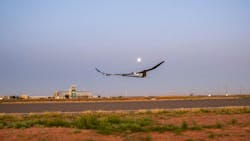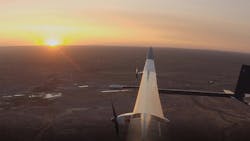Solar Power Keeps Unmanned Aircraft Airborne
Satellites are counted upon for many functions, including communications, navigation and surveillance, although they remain in a limited orbital position. In contrast, the Persistent High Altitude Solar Aircraft (PHASA-35) developed by BAE Systems is a solar electric unmanned aerial vehicle (UAV) aircraft with a 35-m wingspan that can remain airborne for as long as a year, with the flexibility to change positions (and views). It recently successfully completed its maiden flight after a design and development effort of less than two years. It was developed in partnership with Prismatic Ltd.
The high-altitude, long-endurance (HALE) vehicle is designed to operate in the stratosphere, above the weather and conventional air traffic as a cost-effective alternative to a satellite. It is powered by sunlight during the day and by long-life rechargeable batteries at night. The capability to reposition without a pilot at such high altitudes makes it well suited for unique applications, such as maritime surveillance and forest-fire detection.
The long-flying aircraft could even be used as part of the infrastructure of 5G cellular wireless communications networks. Development of the solar-powered UAV was sponsored by the UK Defence Science and Technology Laboratory (DSTL) and the Australian Defence Science and Technology Group (DSTG). The maiden flight took place at the Royal Australian Air Force (RAAF) Woomera Test Range in South Australia, aided by RAAF personnel.
“This is an outstanding early result that demonstrates the pace that can be achieved when we bring the best of British capability together,” Ian Muldowney, engineering director at BAE Systems “To go from design to flight in less than two years shows that we can rise to the challenge the UK Government has set industry to deliver a Future Combat Air System within the next decade.” BAE acquired Prismatic during the design and development of the solar UAV as part of the business plan for the project.
About the Author
Jack Browne
Technical Contributor
Jack Browne, Technical Contributor, has worked in technical publishing for over 30 years. He managed the content and production of three technical journals while at the American Institute of Physics, including Medical Physics and the Journal of Vacuum Science & Technology. He has been a Publisher and Editor for Penton Media, started the firm’s Wireless Symposium & Exhibition trade show in 1993, and currently serves as Technical Contributor for that company's Microwaves & RF magazine. Browne, who holds a BS in Mathematics from City College of New York and BA degrees in English and Philosophy from Fordham University, is a member of the IEEE.

